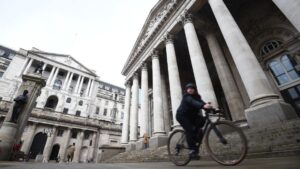The Bank of England has called an end to its pandemic stimulus by declaring that “some modest tightening of monetary policy is likely to be necessary” after warning that inflation will peak at 4 per cent later this year, the highest level in a decade.
Under the Bank’s new forecasts, interest rates rise from 0.1 per cent to 0.2 per cent in 2022, an earlier increase than expected at other central banks, and to 0.5 per cent by August 2024. Rates are projected to rise as the economy recovers strongly on the back of the vaccines and the removal of restrictions.
The Bank expects GDP to return to pre-pandemic levels by the end of the year, growing by 5 per cent in the second quarter and by 3 per cent in the third, and for the lasting economic damage to be only 1 per cent of GDP, lower than the 1.25 per cent it predicted previously. Unemployment has peaked at 4.8 per cent. The pound rose nearly 0.5 cents to $1.3946 after the Bank’s release on the prospect of higher rates, but fell back to $1.3932 later.
All eight members of the monetary policy committee voted to hold rates this month, but Michael Saunders, an external policymaker, wanted to scrap the final £50 billion of quantitative easing to leave the stock at £845 billion.
A majority of the committee judged that “significant progress was being made in eliminating spare capacity and achieving the inflation target sustainably”, a precondition for rate rises. “All meetings are live now,” Rob Wood, UK economist at Bank of America Merrill Lynch, said. “In our view the Bank seems comfortable with a couple of hikes to 0.5 per cent, the first in mid-2022, but there is a much higher bar beyond that.”
Andrew Bailey, the governor, said that the inflation overshoot to twice the Bank’s 2 per cent target would be “transitory” and he rejected suggestions that the MPC was complacent. “If things don’t turn out [as we expect], there is no question we will have to act,” he said.
Inflation was last above 4 per cent in December 2011. The Bank expects it to reach 4 per cent at the end of the year before falling back to 2 per cent as energy prices settle and supply bottlenecks clear. In May, it was forecasting inflation to peak at 2.5 per cent, which has proved to be one of its largest forecast errors. A third of the difference was accounted for by higher energy prices and the rest by supply chain problems, like the microchip shortage. The Bank pointed to forward shipping rates, which show prices dropping back from recent highs, as evidence that recent price spikes will unwind.
A series of recent surveys have shown that worker shortages are driving up wages. The Bank now forecasts earnings growth to peak at 8.5 per cent this year, but emphasised that furlough had distorted the reading. Underlying wage growth is estimated to be 3.5 per cent.
Bailey said: “There are people who we need to see come into the labour market. We need to see unblockages in supply. We think there are signs of that happening.” The Bank said it would raise interest rates to 0.5 per cent before starting to sell its £875 billion gilt portfolio, bought under QE.
Read more:
The Bank of England set to call time on pandemic stimulus
















